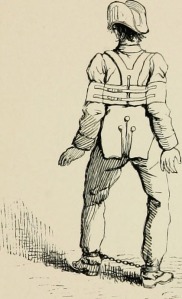Last year I developed an interest in the stories of women committed to insane asylums. Why is this intriguing? For starters, it is important to understand the history of women’s rights in general, and of women’s power to determine their own identity and role in society in particular. The 19th century insane asylum is a hotbed of power issues and a fascinating–yet disturbing–setting for a story. You’ll see this as a common thread in these stories as women attempt to fight back against their prescribed roles.

from “The Insane in Foreign Countries” by William Pryor Letchworth, 1889. “To prevent the body strap from slipping down, a loose circular band of leather extends from the front edge over the head and lodges broadly on the shoulders, which is also secured behind by a loop-hole and small strap attached to one of the rings through which the pin is directed. By this method the whole is preserved from being shifted, and it most completely prevents the use of either hand for any injurious purpose. “
The novels on this list each create a world in which the writer can ask big questions. I’ve got a quotation from Barbara Kingsolver tucked away in my commonplace book that speaks to this:
I devise a very big question whose answer I believe will be amazing, and maybe shift the world a little bit on its axis. Then I figure out how to create a world in which that question can be asked and answered.
~ Barbara Kingsolver, on her writing process
Without further ado, here’s my list:
- Mary Wollstonecraft, Maria, or the Wrongs of Woman. I haven’t read this yet; I’ve only just come across its existence after reading Romantic Outlaws: The Extraordinary Lives of Mary Wollstonecraft and Her Daughter Mary Shelley. Mary Wollstonecraft blazed a path into feminist territory, introducing the concept of egalitarian relationships between men and women. I am a huge Mary Shelley fan (I believe she is the Kevin Bacon of the literary world) and have only just dipped into her mother’s work.
- Sarah Waters, Fingersmith. Set in the late 19th century London slums, this novel twists and turns through a broad range of emotional, physical, and ethical territory. Definitely a provocative page turner.
- Wilkie Collins, The Woman in White. I haven’t read this, but just saw that it likely inspired Fingersmith, so I’m including it. It was first published in 1860 and is a classic mashup of Victorian Gothic and Realism.
- Kathy Hepinstall, Blue Asylum. This one is from the Civil War period and sets the protagonist, Iris Dunleavy, in a state of powerlessness rooted in isolation, both political and geographic. The muggy swampy Florida landscape will draw you into the slow hot world of Iris’ story.
- Margaret Atwood, Alias Grace. This was the story that got me started down this topic path. Set in 1843 Canada, this is based on real events.
- Marcia Hamilcar, Legally Dead: Experiences During Seventeen Weeks Detention in a Private Asylum. This appears to be a work of nonfiction, and it’s interesting to see that the preface was written by a doctor who offers disclaimers and defense of contemporary practices.
- Nellie Bly, Ten Days in a Mad-House. This one is also nonfiction, the work of journalist Nellie Bly who in 1887 pretended to be insane in order to report on the conditions inside Blackwell’s Island Asylum.
- Megan Chance, An Inconvenient Wife. Chance’s narrative gets to the heart of female identity and power in ways that modern readers will relate to. Lucy is an upper-class woman in the 1880s who longs for sex and art, both completely taboo desires for a woman in her position.
Goodness knows there are many more titles out there, and you can easily find longer, better descriptions that what I’ve written here. I’ve linked to Goodreads for most of these, so that’s a great place to start. Listopia has a list called Victorian Asylums, so check that out too. I’m planning to work my way through that list over the course of the year, but I’m terrible at recording what I read on Goodreads. If you are there, let’s connect.
Happy reading!
Here’s a bonus nugget of Quaker history from Max Carter regarding this drawing below:
The Quakers, following in the footsteps of the English Friends who established the world’s first mental hospital, the Retreat in York, in the 1790s, purposefully described it as a hospital and pioneered in using botanical therapy. The azalea gardens are still a major attraction and opened to the public each spring

Philadelphia, 1817. Established by the Society of Friends “for the care of such of their members as may be deprived of their reason.” Image from page 136 of “The institutional care of the insane in the United States and Canada” (1916)
